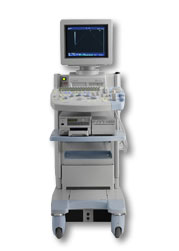Medical Ultrasound Imaging
Sunday, 28 April 2024
'Sampling' Searchterm 'Sampling' found in 13 articles 1 term [ • ] - 12 definitions [• ] Result Pages : •
The sampling rate is the number of samples taken per unit of time. In digital signal processing (Nyquist theory) it is necessary to sample twice as fast as the highest frequency component.
Further Reading: Basics:
•
Interventional ultrasound, also known as ultrasonography, encompasses a range of invasive or surgical procedures guided by ultrasound imaging. While its widest application lies in intravascular ultrasound imaging for measuring atherosclerotic plaque, it has proven valuable in various medical fields. In urology, ultrasound-guided interventions are employed for treatments like high intensity focused ultrasound (HIFU) in prostate conditions. The precise imaging provided by ultrasound aids in targeting the affected area and delivering therapeutic energy effectively. In intraabdominal conditions, endoscopic ultrasound is frequently utilized. This technique combines ultrasound imaging with an endoscope to visualize and evaluate structures within the gastrointestinal tract, allowing for precise diagnoses and targeted interventions. Ultrasound-guided procedures play a significant role in several medical specialties, including liver sonography, obstetric and gynecologic ultrasound, and thyroid ultrasound. These procedures involve interventions such as RF thermal ablation or biopsies, which are guided by real-time ultrasound imaging. For instance, in liver sonography, ultrasound guidance is crucial for performing biopsies or RF thermal ablation, a technique used to treat liver tumors by delivering localized heat to destroy the abnormal tissue. The real-time imaging allows for precise needle placement and monitoring during the procedure. In obstetric and gynecologic ultrasound, ultrasound-guided procedures, such as biopsies, can be performed to obtain tissue samples for diagnostic purposes. Additionally, ultrasound guidance is valuable during interventions like amniocentesis or fetal blood sampling, enabling accurate and safe procedures. Thyroid ultrasound procedures often involve ultrasound-guided fine-needle aspiration biopsy (FNAB), which allows for the sampling of thyroid nodules for cytological examination. The ultrasound image helps guide the needle into the targeted area, ensuring accurate sampling and minimizing potential complications. Overall, ultrasound-guided interventions provide minimally invasive and precise approaches to diagnosis and treatment. The real-time imaging capabilities of ultrasound contribute to enhanced accuracy, safety, and patient outcomes in procedures like biopsies, injections, and drainage. See also Transurethral Sonography, Endocavitary Echography, and B-Mode Acquisition and Targeting. •
According to Shannon's sampling theorem, the sampling frequency should be twice the frequency being sampled. The nyquist frequency is the maximum frequency that can be sampled without aliasing. In ultrasound imaging, it is defined as half of the pulse repetition frequency. NF = PRF/2 (nyquist frequency = pulse repetition frequency/2) This is the so-called Nyquist limit. If the velocity of flow exceeds the Nyquist limit, the direction and velocity are inaccurately displayed and appear to change direction. Color flow Doppler capitalizes on this effect. This allows detecting flow disturbances from laminar to turbulent flow. See also Aliasing Artifact, Repetition Rate, and Sampling Rate. •
(FFT) The fast Fourier transformation is a particularly fast and efficient computational method of performing a Fourier transformation, which is the mathematical process by which raw data is processed into a usable image. The fast Fourier transform analyzer is a common device that performs spectral analysis in ultrasound instruments. In this case, it displays different quadrature Doppler frequencies or reflector velocities when a sample volume cursor is used along time. The Doppler frequency is proportional to the spectral reflector velocity. See also Proportionality Constant, and Sampling Rate. •  From Hitachi Medical Corporation (HMC), sales, marketing and service in the US by Hitachi Medical Systems America Inc.
From Hitachi Medical Corporation (HMC), sales, marketing and service in the US by Hitachi Medical Systems America Inc.The HI VISION™ 5500 - EUB-5500 fully digital ultrasound system delivers the latest generation of signal processing technology, sophisticated transducer design, and a host of features and options for advanced imaging capabilities across a wide range of clinical situations. This system is compatible with all Pentax ultrasound endoscopes.
Device Information and Specification
APPLICATIONS
Abdominal, brachytherapy/cryotherapy, breast, cardiac, dedicated biopsy, endoscopic, intraoperative, laparoscopic, musculoskeletal, OB/GYN, pediatric, small parts, urologic, vascular
CONFIGURATION
Compact system
Five frequency (except mini-probes)
Linear, convex, radial, miniradial/miniprobe, biplane, phased array, echoendoscope longitudinal, echoendoscope radial
3 modes of dynamic tissue harmonic imaging (dTHI), pulsed wave Doppler, continuous wave Doppler, color flow imaging, power Doppler, directional power Doppler, color flow angiography, real-time Doppler measurements
IMAGING OPTIONS
3RD generation color artifact suppression
OPTIONAL PACKAGE
STORAGE, CONNECTIVITY, OS
Patient and image database management system, HDD, FDD, MOD, CD-ROM, Network, DICOM 3.0, Windows XP
DATA PROCESSING
H*W*D m (inch.)
1.40 x 0.51 x 0.79 (55 x 20 x 31)
WEIGHT
130 kg (286 lbs.)
POWER CONSUMPTION
1.2kVA
ENVIRONMENTAL IMPACT
4096 btu/hr heat output
Result Pages : |
Medical-Ultrasound-Imaging.com
former US-TIP.com
Member of SoftWays' Medical Imaging Group - MR-TIP • Radiology TIP • Medical-Ultrasound-Imaging
Copyright © 2008 - 2024 SoftWays. All rights reserved.
Terms of Use | Privacy Policy | Advertise With Us
former US-TIP.com
Member of SoftWays' Medical Imaging Group - MR-TIP • Radiology TIP • Medical-Ultrasound-Imaging
Copyright © 2008 - 2024 SoftWays. All rights reserved.
Terms of Use | Privacy Policy | Advertise With Us
[last update: 2023-11-06 01:42:00]




